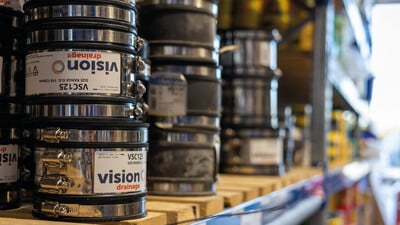Land drain pipe systems are essential for managing excess groundwater on everything from construction sites to farmland and landscaped gardens. But for the system to function properly, land drain piping needs to be integrated with other components, including solid underground drainage, soakaways, and access chambers.
These aren’t always like-for-like connections. Land drain is flexible, perforated, and unsocketed, while underground drainage pipe is rigid, solid-walled, and push-fit. That means joining the two requires specialist connectors and a good understanding of how each element works.
The good news? With the right fittings from Drainfast, connecting these systems is straightforward – and this guide walks you through each step.
Common Connection Scenarios & How to Solve Them
Connecting Land Drain Pipe to Underground Drainage
Where land drain needs to discharge into a standard 110mm or 160mm PVC-U drainage system, the two pipe types must be made compatible using a combination of adaptors.
Start with a land drain coupling to secure the corrugated pipe end. Then use a PVC underground pipe adaptor or reducer to step it into the solid pipe socket.
Where there is any misalignment or movement, a flexible rubber coupling with jubilee clips can help create a secure, watertight seal.
Connecting to a Soakaway Crate System
Land drainage is often used to direct water into a soakaway system, allowing it to disperse into the surrounding ground. Most soakaway crates are designed for solid pipe connections — typically 110mm.
To make this work, insert a short section of solid drainage pipe into the crate’s inlet, then use a land drain to solid pipe adaptor to join it to the perforated land drain pipe.
In some systems, you can insert land drain directly into the crate using a rubber seal or grommet, though this must be carefully sized to avoid soil ingress or leakage.
Connecting to an Inspection Chamber
Inspection chambers provide maintenance access and are a vital feature of any robust drainage design. Most have push-fit inlets to accept 110mm or 160mm solid pipe.
To connect land drain to an inspection chamber, first use a solid pipe spigot or adaptor at the chamber entry, then attach the land drain via a corrugated pipe coupling or flexible connector.
A double socket coupler can also be used to neatly join solid and flexible elements.
If the chamber is supplied with a seal for standard pipe, check whether an adaptor ring or collar is required for compatibility with corrugated systems.
Joining Two Land Drain Pipes
Where two lengths of land drain pipe need to be joined, a land drain coupler is all that’s needed. This simple sleeve-style fitting grips the outer ribs of the pipe to create a firm mechanical join.
In areas with a high silt content, it’s wise to wrap the join with geotextile tape or install a geotextile sock over the pipe to prevent sediment from entering the system.
To Seal, or Not to Seal
Land drain pipe is designed to collect water, not carry it under pressure. For that reason, joins between two land drain pipes do not need to be watertight. In fact, the system is built on the principle of water ingress.
However, where land drain connects to a sealed drainage pipe, soakaway or chamber, the connection must be watertight to ensure water only flows where intended. This is where flexible couplings, adaptor seals and properly sized fittings are critical.
Pipe Sizes and Compatibility
The most widely used land drain pipe diameters are 80mm and 100mm, while most solid underground drainage systems operate at 110mm or 160mm.
The following sizes and compatible fittings are available from Drainfast:
- Perforated land drain in 60, 80, 100 and 160 mm diameters
- Perforated land drain, geotextile wrapped, in 100 mm diameter
- Unperforated land drain, in 100 mm diameter
- Land drainage couplers, junctions and end caps for 60, 80, 100 and 160 mm diameters
- Solid underground drainage pipe and fittings in 110 mm diameter
- Solid underground drainage pipe and fittings in 160 mm diameter
For less typical installations such as large diameter pipework or site-specific layouts, Drainfast’s technical team can advise on specialist or bespoke connection options. If you would like to discuss a specific project, contact the team on 01420 555600.

Written by
Bob Stone
Technical Sales
Heading up our Technical Estimating Department, Bob is our in-house quantity surveyor.

